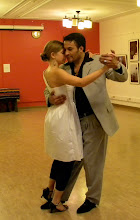What does a good "Talk of the Town" accomplish? In trying to construct my own, I thought of the few I'd read on the New Yorker's website, and wondered what exactly I was supposed to attempt. None of the piece were what I expected: a true scene set in New York City that revealed something about the place and the people involved. I wanted description. I wanted dialogue and drama. Although both of my favorite pieces--"Have Gun" about female taser-purchasing parties and Powder Room 101--gave an unusual setting and set of circumstances, I was in general underwhelmed with the form. It felt flat and overly academic, whereas I wanted something truly engaging. In my own piece I attempted to combat this by providing (I should say merely chronicling, as life provided the scene) all the things that I want out of a good short story: fleshed-out characters, conflict, humor and a bigger consciousness of the world presented. I don't know if I succeeded at including all this, but I sure did try. I wanted to present the novelty and tension inherent in Oberlin's art rental program, as well as a sketch as the varied students it attracts.
One problem I encountered is a personal one: I wrote about my friends. I did change the names, but I found myself in an ethical dilemma that many writers--fiction and otherwise--must face. Will people recognize who I'm writing about? Will word get back to them? Will they be angry at a less-than-flattering portrayal? Can I ever publish this?
I suppose one thing the pieces in the New Yorker have that mine does not is a good, informative background. Like a good journalist, these writers answer the who, what, when and where near the beginning. But the assignment called for an assumed Oberlin audience, so perhaps not explaining the particulars of art rental is a good thing.
Also, perhaps I wasn't lofty enough with a higher goal in writing this piece. In the piece on the "taser party," the author hints at a darker undertone: women feel so unsafe that they imagine they need violent protection against violence. Carrying a weapon has become mainstream. While this is a very New York idea--perfect for the New Yorker, obviously--it also touches on a national trend, and a worrysome one at that. What greater trend does mine reveal? Art snobbery? Rude teenagers? These aren't exactly ground-breaking concepts. All that I can hope is that my piece gives the reader some insight into Oberlin as it entertains.
Subscribe to:
Post Comments (Atom)

No comments:
Post a Comment